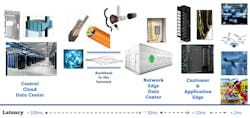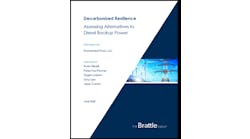Facing the Challenges of Today’s Modern Data Center: Standing at the Edge
The global pandemic has advanced digital transformation by several years as it’s changed the way we approach almost all aspects of life.
Digital transformation refers to the process of digitizing a network’s infrastructure through technology, and COVID-19 has shown us that we can conduct most all parts of our lives digitally. Applications including work-from-home, school-from-home and telehealth have become the “new normal.” But even more advanced applications such as autonomous vehicles, remote surgeries and smart agriculture are also becoming a reality.
As technologies evolve, so do their capabilities as they continue to become part of our everyday life. In today’s hyperconnected world, companies need a way to scale and analyze data faster, cheaper and better. The only way to do that is to move out of the cloud and on to the edge of the network where most of the future data will be generated.
Although public and hybrid cloud solutions will continue to dominate the data center space in the near future, another dynamic has come into play – the Emerging Edge. The edge is not just one thing – it’s a continuum or an ecosystem made up of six distinct layers that spans anywhere between the user end-device at the edge of the network and the cloud:
- Cloud Data Center
- MetroEdge and Colocation
- Central Office
- Facility, Factory, Campus and Venue
- Macro Site, Small Cell, CRAN, FWA and Private LTE
- OSP Cabinets/Fixtures
It’s said that the edge is ushering in the third act of the internet. Since its formation, the internet has experienced three separate acts – the first act beginning around the 1980s to 1990s with the introduction of the internet. During this era, large, centralized data centers were the main infrastructure, the web browser made its first appearance and users were primarily concerned with getting data from point A to point B. As the internet grew, the second act took place between the 2000s to the 2020 timeframe. This act consisted of the Regional Internet, including regional data centers, content delivery networks and one of the key drivers being 3G and 4G cellular devices. Now, we are in the third act, which can be thought of as the local internet or the internet at the edge. Cellular data networks, such as 4G and the capabilities of 5G, play a critical role in enabling real-time applications that will require compute and storage capabilities closer and closer to the edge.
As wireless technology evolves and data rates continue to rise, the need for compute power as close as possible to the application becomes even greater. An IDC report forecasts that worldwide spending on edge computing solutions is expected to reach nearly $274 billion by 2025. Additionally, the global capital expenditure on IT equipment for the edge infrastructure is projected to grow to $104 billion by 2028 according to a recent State of the Edge report. One of the primary drivers of this emerging edge is usable data creation, which is the amount of data that’s created by the devices we wear and that are in our homes or cars.
Computing at the edge “extends” the cloud network by bringing it closer to the end user device, or application, and delivers services such as compute storage and processing power. This relieves the load on the cloud data center processing units and reduces traffic between applications and the cloud. As a result, edge computing reduces overall data backhaul, which increases network efficiency by freeing up bandwidth and decreasing costs.
Edge computing also reduces latency, which can be thought of as the currency of the edge. When thinking about tomorrow’s emerging applications, such as self-driving cars and remote surgeries, low latency is crucial to enabling them. The Near-Edge isn’t sufficient for tomorrow’s transformational applications where a split second can make a difference between life and death. For example, autonomous cars will not only need to control and drive themselves, but they will also need to “talk” to the other vehicles on the road as well as the smart city infrastructure to understand where you are.
Edge computing has the potential to unleash a variety of advanced use cases resulting in new user experiences and new business opportunities. Achieving this will require both high data rates and low latency, and edge data centers are key to this emerging reality.
Manja Thessin is Enterprise Market Manager at AFL. Seán Adam is Vice President of Market Strategy and Innovation at AFL, an international manufacturer providing end-to-end solutions to the energy, service provider, enterprise, hyperscale and industrial markets. Contact AFL to learn more about their solutions.







